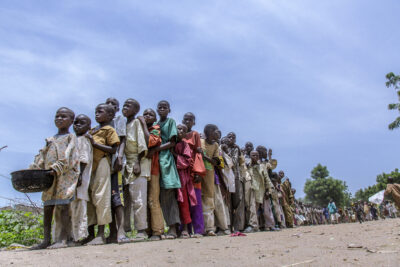In November of 2016, the FARC-EP (Revolutionary Armed Forces of Colombia–People’s Army) and the Colombian state signed historic peace accords, ending more than 52 years of war. The internal armed conflict in Colombia killed 218,094 people between 1958 and 2012 and displaced 7.3 million. The 2016 peace accords outline an ambitious plan for a postconflict Colombia, including the establishment of a transitional justice court to adjudicate war crimes, crop substitution programs for coca and poppy farmers, a truth commission, and a proliferation of bureaucracies to manage postconflict development programs. We began our fieldwork in Colombia at this promising postconflict moment, researching programs that seek to “repair” victims of the armed conflict and rehabilitate and reintegrate ex-combatants.
Our work in accompanying and observing these programs led us to ask: When and where is Colombia postconflict? And what kind(s) of people do postconflict programs envision? We begin with two scenes from our fieldwork that challenge the idea that the postconflict is peace. We then discuss how programs to repair victims and reintegrate ex-combatants both seek to produce prosperous and productive people. The similarities between these two programs suggest that in Colombia, the postconflict future is not just a political project but also an economic one.
***
Tumaco: On August 3, 2017, the flight from Bogotá to the coastal town of Tumaco landed at 7:30 a.m. It was filled with the usual suspects in postconflict priority areas: state officials and staff from international organizations like the IOM (International Organization for Migration) and foreign aid organizations like USAID. I looked out the window while I tried to call my contact at the Office for the Substitution of Illicit Crops and was shocked to see seven attack helicopters outside and Colombian troops all over the small airport. I went to Tumaco to observe a state reparation program for women victims of sexual violence. Though I knew how dangerous Tumaco was (it has long been a strategic point for moving coca, the raw material for cocaine), I expected to be in a newly pacified territory. This was the promise of the peace accords with the FARC in 2016. Finally, my contact answered the phone. I asked him (naively) if all those troops and helicopters were at the airport because now that the conflict was over they weren’t needed anymore. He laughed and said, “OK, now I can tell you we are in the middle of military operations. I want you to go straight to your hotel. Do not talk to anyone; Tumaco is not safe.” For the next three days, I participated in various state-sponsored workshops where victims of the armed conflict were invited to identify as survivors and Colombia was described as a postconflict society. The workshops took place in a gated hotel in a fully militarized town.
Catalina Vallejo Pedraza
Bogotá: After the peace accords, the FARC transformed into a political party. They kept their wartime acronym but changed their name to the Common Alternative Revolutionary Force. In spring of 2018, the new party ran its first political campaign. I accompanied the FARC congressional campaign in Bogotá as part of my research on combatant demobilization and reintegration programs. The campaign focused on poor neighborhoods in Bogotá, on “voters who don’t vote,” many of them victims of the armed conflict displaced from rural areas. In a community meeting in February, I watched as ex-combatant political candidates apologized to representatives of a victim’s association in Usme, a southern peripheral neighborhood. They listened as victims shared stories of displacement and loss, and signed a pact promising to work together towards peace. That night, a FARC ex-combatant in Ciudad Bolívar, another peripheral neighborhood in Bogotá, was shot six times in front of his home. He survived only because he’d forgotten to take off his bulletproof vest; he works as a bodyguard during the day. An ex-combatant interlocutor who had led the meeting just a few hours before in Usme texted me that night: “I’ve never been this afraid, not even during the war.” 1In postconflict Colombia, a former FARC combatant is assassinated by criminal and paramilitary groups every six days. Since the peace accords were signed in November, at least sixty-four ex-combatants have been killed.
Emma Shaw Crane
***
Victims receive symbolic postwar reparations as attack helicopters roar overhead; former combatants campaign for the FARC political party and hours later are shot in the street. These are the paradoxes of postconflict Colombia. From previously contested territories like Tumaco to the peripheral neighborhoods of the capital, Bogotá, victims and perpetrators alike navigate postconflict programs alongside active war. In many areas of Colombia, especially in places with a high concentration of illegal crops, the “postconflict” seems to be about introducing new legal and technical language to manage old problems. Instead of marking the end of war, postconflict projects and bureaucracies articulate the coexistence of violence with new state projects of development, including the substitution of illegal crops, land restitution, combatant demobilization, and the reparation of victims. As a lieutenant commander with US Southern Command (the US regional command responsible for military aid to Colombia) told one of us in Miami, “We will continue to fight narco-terrorists in Colombia. Things haven’t changed that much.” The disarmament of the FARC and the expansion of state “humanitarian bureaucracies” to meet the needs of victims and ex-combatants have not guaranteed an end to conflict. 2Juan Pablo Vera Lugo, “The Humanitarian State: Bureaucracy and Social Policy in
Colombia” (PhD dissertation in Anthropology, Rutgers State University of New Jersey, 2017). And with the recent presidential election of Iván Duque, the political protégé of former president Álvaro Uribe, who has long opposed the peace accord, the future of the peace accord is even more precarious. And since the accords, hundreds of social movement leaders have been assassinated.
Taking the War Out of People: Postconflict Subjectivities
The reparation of victims in Colombia is carried out by the Victims’ Unit, and the reintegration of former combatants (from both guerrilla and paramilitary groups) is facilitated by the Agency for Reincorporation and Normalization (ARN). Researchers generally work on victims or ex-combatants, and these two groups and institutions are often understood to be in opposition: innocent victims, guilty perpetrators. However, there are striking similarities between the institutions that manage these two (sometimes overlapping) groups. Both are state bureaucracies established during the war; both are now emblematic programs of the postconflict. And they are both structured around interventions that aim to transform individual behaviors and emotions by teaching people how to change their lives and behavior. For victims, the focus is on healing suffering and empowerment; for ex-combatants, on reintegration into civilian and family life. The Victims’ Unit and the ARN both seek to produce an economically independent subject capable of turning state aid into a proyecto de vida (a life project) that generates a sustainable livelihood—for example, a small business or professional job. Where international law sees the “life project” 3The idea of “life project” comes in part from the Interamerican Court of Human Rights, which has insisted that countries repair victims for harms impacting their personal fulfillment. More specifically the Court defines life project as “the integral fulfillment of the affected person, considering her vocation, aptitudes, circumstances, potentialities and aspirations, which allow him to reasonably fix certain expectations and fulfill them”. Calderon Gamboa, Jose Francisco. 2006. Reparación de daño al proyecto de vida por violaciones a los Derechos Humanos. Buenos Aires: Editorial Porrua. Accessed at: http://www.corteidh.or.cr/tablas/24484-1.pdf as a means to quantify lost potential, Colombia’s postconflict bureaucracies have developed it into a set of lessons, criteria, and requirements for their beneficiaries. In Colombia, it is not just a postconflict society that must be built. It is also the subjects who will be a part of it.

Routes to Peace
The Colombian state has organized the twinned processes of “repairing” victims and reintegrating former combatants into “routes.” Each individual—whether a victim or an ex-combatant—must navigate a set of linear bureaucratic steps, including psychosocial attention, education, housing opportunities, financial education, and small-business training. The route for victims focuses on economic reparation for their loss and moving on from trauma, and the route for ex-combatants focuses on the transition to legal citizenship and reintegration into civilian social worlds. These routes, and the promises they make to participants, are similar to a variety of state programs aimed at alleviating poverty. They combine social assistance (for example, access to basic rights like education and housing) with transitional justice mechanisms like reparations and reintegration.

Individual Reparation Route for Victims: This is the diagram used by the Colombian government to explain the different steps and offices inside the state that victims must navigate in order to be officially recognized as a victim and to have access to reparations. The steps are tailored to be followed individually and include access to economic and symbolic reparations in addition to housing, jobs, land, health care, and loans.
Economic compensation is an important part of the reparations route for victims. In Colombia, economic reparations started during the government of Álvaro Uribe in 2008 and became a national, comprehensive policy with the passage of the Victims Law in 2011, during the presidency of Juan Manuel Santos. There are 6.5 million officially recognized victims eligible for compensation in Colombia, a massive fiscal and institutional challenge for a state with limited resources—making this a hard policy to justify.4Peter Dixon, “Reparations, Assistance, and the Experience of Justice: Lessons from Colombia and the Democratic Republic of the Congo,” International Journal of Transitional Justice 10, no. 1 (2016): 88–107. How to explain that 10 percent of the national population will receive a check between US$4,000 and $10,000? As one of the engineers of the policy put it, there was a fear in Congress that people were going to use this money on “putas y trago”—whores and alcohol. To calm this anxiety, proponents of the law included a section in which they committed to developing a program to promote the responsible use of reparations money. This promise materialized in 2013 with the Program for the Adequate Investment of Resources, which encourages victims to make their reparation economically productive. The program offers a variety of options, including investment in housing, starting a small business, and acquiring land, and encourages combining the compensation with microcredit loans.
“DO NOT RUSH!
Invest your compensation when you are sure that you made the best decision possible. If you need more information get in contact with the officer in charge of the Program for the Adequate Investment of Resources in your area”5In Spanish the message reads: “¡No te apresures! Invierte los recursos de indemnización cuando estés seguro/a de haber tomado la mejor decisión. Si quieres más información, ponte en contacto con el/la Enlace del Programa de Acompañamiento en tu dirección territorial.”
This message was printed on flyers handed out to victims during a collective check delivery carried out in Popayán in October 2017. Even though the Program for the Adequate Investment of Resources is technically voluntary, all victims are given advice on how to invest any funds they receive. While waiting for their compensation, victims listened to the state official say: “Please take care of this money. The government will not give it to you again, even if you get robbed or scammed.” After the warning, the Victims’ Unit clerk introduced, one by one, the stands spread across the large school auditorium where the ceremony was taking place. One could hear over the speaker that people from the Agrarian Bank, various for-profit universities, and even a paramedic training center were marketing themselves as the best way to invest the compensation. During these ceremonies, state officials strongly refute the idea that money and suffering can be thought of in equivalent terms or that they are “pagandoles por sus muertos,” paying victims for their dead. However, they have developed a program predicated on the belief that a better economic future can be built if the compensation born of suffering is used wisely.
Despite the Victims’ Unit’s intention to promote financially responsible investments, not all victims conformed with the state’s expectations. The status of victim is one that is constantly being negotiated, and individuals use it with different purposes depending on whom they are interacting with.6Roxanne Krystalli, “Three Lessons from Victims’ Day in Colombia,” Political Violence at a Glance, April 18, 2018, https://politicalviolenceataglance.org/2018/04/18/three-lessons-from-victims-day-in-colombia/. During a workshop organized to help female victims invest in small businesses, one could hear women narrate with enthusiasm and gratitude the list of investments they had made: a bakery, a fast food street stand, and a laundry machine renting service. Later that day during lunch and without state officials around, the same group complained about how some of these businesses failed and how some of them used the reparation money to pay off past debt. These different responses shed light on how victims are not passive recipients of state help but active users who at moments may submit and perform a certain kind of financial “good sense,” but who also subvert the intentions of the individual reparation route.
From Perpetrators to (Productive) Citizens

The Reintegration Route: This diagram illustrates the Agency for Reincorporation and Normalization route for the demobilization and reintegration of former combatants. It emphasizes a return to the nuclear family and a transition from rural places to urban centers via psychosocial attention, education, and economic reinsertion in the form of “seed capital to invest in your own business, housing, or education.”
The peace accords with the FARC established a plan for the collective reincorporation of the remaining 7,100 guerrillas, who arrived to special rural “zones” to turn in their arms and begin their transition to civilian life. But long before the collective reincorporation of the FARC, the Colombian state reintegrated over 59,000 guerrilla and paramilitary combatants through an individual program that began during the government of Álvaro Uribe (2002–2010). Individual demobilization was a kind of counterinsurgency, intended to weaken enemy armies “drop by drop,” collecting valuable information and resettling former fighters into urban neighborhoods. Like the economic reparations process for victims, the reintegration route for ex-combatants is an individual process. After disarming and providing the Colombian Ministry of Defense with information, former combatants are transferred to the ARN. There, they begin a multiyear reintegration process that focuses on remaking former combatants into well-adjusted citizens, who blend in with the communities that receive them and leave behind their violent (and violently politicized) pasts.
The reintegration route, which takes roughly six and a half years to complete, is organized around eight “dimensions” (the personal, productive, familial, and environmental, and the health, education, citizenship, and security of each ex-combatant). In ARN material and workshops, the route begins in el monte (which roughly translates as the woods), often symbolized by trees. The demobilizing combatant is greeted by his family (a woman and child) and continues on through programs and institutions representing each dimension. The route ends in a gleaming city. In a recent ARN video, shown at reintegration workshops, the ex-combatant’s path is explained as a balance between compromisos (obligations) and beneficios (benefits):

In this simplified route, the combatant again begins in el monte, and receives health care, education, a credit card, a diploma, and, eventually, an apartment. Through this process the combatant is transformed from an armed group member into an autonomous individual, capable of making his or her own choices. Financial independence and correct fiscal choices, symbolized by the credit card, are crucial. As one IOM report declared, “From Demobilized Combatants to Business Owners with a Future.”
One official, a former soldier, compared the reintegration of ex-combatants to raising his two-year-old daughter. He said, “I hold her in my arms, give her love and support, teach her to tie her shoes.” Like raising a child, demobilization is about “formando un ser humano,” creating a human being. For the interviewed officials and experts, demobilization from an armed group is about teaching people to practice free will and to take responsibility for past crimes. When asked what the biggest challenge for reintegrating ex-combatants is, most of my interlocutors say, “poder manejar su comportamiento”—learning to manage their behavior. To reintegrate is to transform from a dangerous insurgency into a reasonable citizen, and to learn to manage the self.
Former combatants contest and subvert the ARN’s vision of reintegration. The FARC party is highly critical of this model and has insisted on a collective reincorporation project organized around economically productive projects for groups of former combatants. As one former FARC commander explained, “What the state wants is a negotiation with each individual guerrilla. They want each of us to go home and resolve our problems alone, as best we can.” Yet in the face of the state’s failure to implement the accords, more than half of former FARC combatants have left the rural reintegration zones. As one official warned, many will “recycle” through the individual reintegration process in order to receive the basic, individual support that the program offers. Despite the efforts of the FARC to demobilize collectively, the vision of the state remains resolutely individual. And like victims, reincorporating combatants must learn to navigate bureaucracies that expect a certain kind of comportment.

The Colombian Postconflict Project
There are crucial differences between the “routes” and bureaucracies for ex-combatants and victims. Ex-combatants are imagined to be men, dangerous and aggressive; victims are imagined as women, suffering and traumatized. Demobilization programs seek to prevent recidivism into criminal violence through economic opportunity and integration into normative family structures, and victims’ programs seek to empower victims to seize control of their lives. Yet, despite these differences, our research reveals that both victim and ex-combatant programs seek to prepare individuals for a prosperous postconflict future. The reparations and reintegration routes demand the emotional transformation of participants: victims must learn to place suffering in the past, and combatants must learn to be less violent. Person by person, these postconflict “routes” produce new postwar subjectivities, even as armed conflict continues.
The language of economic empowerment permeates these interventions and tells us something about what the future bureaucrats and experts within the postconflict project imagine and the kinds of people a prosperous postconflict requires. Dangerous former combatants are transformed into productive individuals and suffering victims into independent investors. The Victims’ Unit and the ARN demand discipline, austerity, and emotional stability and, in exchange, promise ex-combatants and victims not only a peaceful society but a good life: class mobility, job stability, social equality. The routes are represented not only as a way to repair the violence of the armed conflict but also a way out of poverty.
However, in practice these expectations are not attainable by all victims and perpetrators. Victims and ex-combatants are disproportionately poor people. The postconflict apparatus, funded by international donors and the Colombian state, is not just about a new era of human rights in the wake of war. It is also a development project.7Chandra Lekha Sriram, “Liberal Peacebuilding and Transitional Justice: What Place for Socioeconomic Concerns?” in Justice and Economic Violence in Transition, ed. Dustin N. Sharp (San Diego: Springer, 2014). But can a society of savvy small entrepreneurs transform worlds structured by poverty and wartime violence? The focus on economic empowerment within each “route” invites victims and ex-combatants to acquire debt and invest in small businesses that exist within a precarious informal economy (for example, street vending). These enterprises often bring people previously outside of debt (such as freshly arrived ex-combatants) into new relationship with global financial capital.8Ananya Roy, Poverty Capital: Microfinance and the Making of Development (London: Routledge, 2010).
Postconflict bureaucracies are saturated with good intentions: these routes to peace promise to put war in the past, and who wouldn’t want that? Our research with experts, program managers, and participants in reparation and reintegration projects suggests that these projects rely on what feminist theorist Lauren Berlant calls cruel optimism: they invite those most impacted by war to believe in the elusive promises of economic development through smart personal choices, exacerbating economic vulnerability and normalization precarity.9Lauren Berlant, Cruel Optimism (Durham: Duke University Press, 2011).















